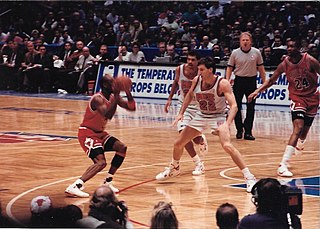
Basketball is a team sport in which two teams, most commonly of five players each, opposing one another on a rectangular court, compete with the primary objective of shooting a basketball through the defender's hoop, while preventing the opposing team from shooting through their own hoop. A field goal is worth two points, unless made from behind the three-point line, when it is worth three. After a foul, timed play stops and the player fouled or designated to shoot a technical foul is given one, two or three one-point free throws. The team with the most points at the end of the game wins, but if regulation play expires with the score tied, an additional period of play (overtime) is mandated.

Volleyball is a team sport in which two teams of six players are separated by a net. Each team tries to score points by grounding a ball on the other team's court under organized rules. It has been a part of the official program of the Summer Olympic Games since Tokyo 1964. Beach volleyball was introduced to the programme at the Atlanta 1996 Summer Olympics. The adapted version of volleyball at the Summer Paralympic Games is sitting volleyball.
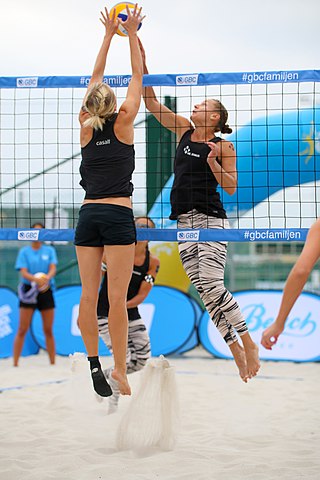
Beach volleyball is a team sport played by two teams of two players each on a sand court divided by a net. Similar to indoor volleyball, the objective of the game is to send the ball over the net and to ground it on the opponent's side of the court. Each team also works in unison to prevent the opposing team from grounding the ball on their side of the court.

In sport, a goal may refer to either an instance of scoring, or to the physical structure or area where an attacking team must send the ball or puck in order to score points. The structure of a goal varies from sport to sport, and one is placed at or near each end of the playing field for each team to defend. For many sports, each goal structure usually consists of two vertical posts, called goal posts, supporting a horizontal crossbar. A goal line marked on the playing surface between the goal posts demarcates the goal area. Thus, the objective is to send the ball or puck between the goal posts, under or over the crossbar, and across the goal line. Other sports may have other types of structures or areas where the ball or puck must pass through, such as the basketball hoop. Sports which feature goal scoring are also commonly known as invasion games.
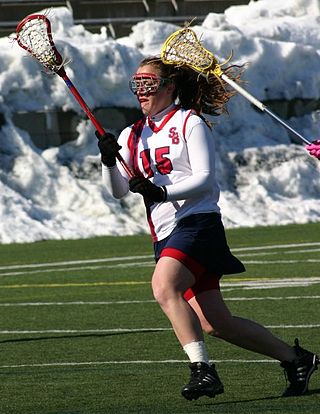
Women's lacrosse, sometimes shortened to lax, is a field sport played at the international level with two opposing teams of ten players each. Originally played by indigenous peoples of the Americas, the modern women's game was introduced in 1890 at the St Leonard's School in St Andrews, Scotland. The rules of women's lacrosse differ significantly from men's field lacrosse. The two are often considered to be different sports with a common root.
Dead ball is a term in many ball sports in which the ball is deemed temporarily not playable, and no movement may be made with it. Depending on the sport, this event may be quite routine, or more uncommon.

Tchoukball is an indoor team sport, played by teams of 7 players. It was developed in Switzerland in the 1970s, and is most popular in Singapore, Switzerland and Taiwan, but has become an international sport with national federations in over 60 countries. It is governed by the International Tchoukball Federation (FITB), which was founded in 1971.
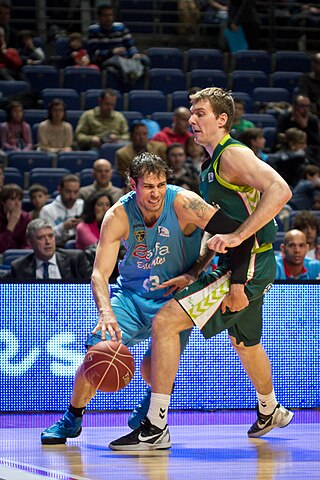
In basketball, a personal foul is a breach of the rules that concerns illegal personal contact with an opponent. It is the most common type of foul in basketball. A player fouls out on reaching a limit on personal fouls for the game and is disqualified from participation in the remainder of the game.

Oină is a Romanian traditional bat-and-ball game, similar in many ways to baseball.
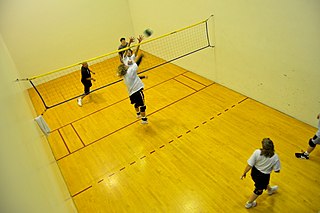
Wallyball is a fast-paced sport that is similar to volleyball played in a racquetball court, where it is legal to hit the ball off of the walls.
In gridiron football, clock management is an aspect of game strategy that focuses on the game clock and/or play clock to achieve a desired result, typically near the end of a match. Depending on the game situation, clock management may entail playing in a manner that either slows or quickens the time elapsed from the game clock, to either extend the match or hasten its end. When the desired outcome is to end the match quicker, it is analogous to "running out the clock" seen in many sports. Clock management strategies are a significant part of American football, where an elaborate set of rules dictates when the game clock stops between downs, and when it continues to run.

Pickleball is a racket or paddle sport in which two players (singles) or four players (doubles) hit a perforated, hollow plastic ball with paddles over a 34-inch-high (0.86 m) net until one side is unable to return the ball or commits a rule infraction. Pickleball is played indoors and outdoors. It was invented in 1965 as a children's backyard game in the United States, on Bainbridge Island in Washington state. In 2022, pickleball was named the official state sport of Washington.

Cycle polo, bicycle polo, or bike polo is a team sport, similar to traditional polo, except that bicycles are used instead of horses. There are two versions of the sport: Hardcourt Bike Polo and grass court bike polo. The hardcourt game saw a sharp spike in interest in the first decade of the 21st century and new teams are sprouting up across the world in China, Canada, Ireland, Switzerland, France, India, Germany, Pakistan, Ukraine, Russia, Malaysia, Sri Lanka, Indonesia, Hungary, Australia, New Zealand, Sweden, England, Scotland, Argentina, Italy, Spain, United States, Poland, Croatia, Slovenia, Lithuania, Nepal, Brazil and Cuba.

Ball badminton is a sport native to India. It is a racket sport game, played with a yellow ball made of wool, on a court of fixed dimensions divided by a net. The game was played as early as 1856 by the royal family in Tanjore, the capital of Thanjavur district in Tamil Nadu, India. It enjoys the greatest popularity in India. Ball badminton is a fast-paced game; it demands skill, quick reflexes, good judgment, agility, and the ability to control the ball with one's wrist.
The following terms are used in water polo. Rules below reflect the latest FINA Water Polo Rules.
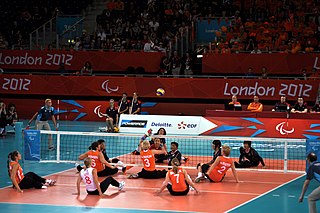
Sitting volleyball is a form of volleyball for athletes with a disability. As opposed to standing volleyball, sitting volleyball players must sit on the floor to play.

A penalty shot or penalty kick is a play used in several sports whereby a goal is attempted during untimed play. Depending on the sport, when a player commits certain types of penalties, the opposition is awarded a penalty shot or kick attempt. The rules on how a player attempts a penalty shot or kick also varies between sports.
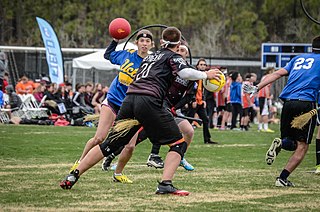
Quidditch, officially known as quadball since 2022, is a team sport that was created in 2005 at Middlebury College in Middlebury, Vermont, United States, and was inspired by the fictional game of the same name in the Harry Potter books by the author J. K. Rowling. Two teams of seven players each, astride broomsticks and opposing each other on a rectangular pitch, compete with the primary objective of passing a ball through the defenders' hoops, while preventing their opponents from passing it through their own hoops. The real-world sport is sometimes referred to as "muggle quidditch" to distinguish it from the fictional game of the books, which involves magical elements such as flying broomsticks and enchanted balls—a muggle in the Harry Potter series being a person without magical abilities. The sport is played around the world.
Basketball is a ball game and team sport in which two teams of five players try to score points by throwing or "shooting" a ball through the top of a basketball hoop while following a set of rules. Since being developed by James Naismith as a non-contact game that almost anyone can play, basketball has undergone many different rule variations, eventually evolving into the NBA-style game known today. Basketball is one of the most popular and widely viewed sports in the world.
This glossary provides definitions and context for terminology related to, and jargon specific to, the sport of pickleball. Words or phrases in italics can be found on the list in their respective alphabetic sections.















